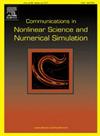Abnormal dynamics in cascading models for time-weighted path optimization
IF 3.4
2区 数学
Q1 MATHEMATICS, APPLIED
Communications in Nonlinear Science and Numerical Simulation
Pub Date : 2025-04-06
DOI:10.1016/j.cnsns.2025.108823
引用次数: 0
Abstract
In real traffic networks, route choice preferences tend to prioritize the shortest travel time over the shortest distance. To address this, we propose a cascading failure model that incorporates time dynamics. By introducing the BPR function, our model quantifies edge transmission time, identifies time-optimal paths, and distributes loads proportionally based on edge time weights. Three parameters are introduced to redefine cascading dynamics and evaluate network robustness.Simulations on both artificial and real-world networks reveal several key findings: First, increasing node weights leads to an uneven load distribution, thereby weakening the network’s robustness. Second, the network exhibits both the “capacity paradox” and the “expansion paradox.” The capacity paradox indicates that increasing the capacity of edges can actually reduce network robustness. In networks with loop structures, enlarging edge capacities redirects traffic to critical edges, creating bottlenecks that amplify cascading failures. Similarly, the expansion paradox shows that increasing maximum capacity can destabilize the network by concentrating loads on key edges, which, if overloaded, can trigger widespread failures. These findings challenge the conventional assumptions that enhancing capacity universally improves robustness. Instead, our results emphasize the importance of balancing topological design and load distribution.For practical networks, strategies such as diversifying travel routes and limiting the load on hub nodes prove to be more effective than simply increasing capacity. This work advances cascading failure modeling by integrating time dynamics and provides actionable insights for improving infrastructure resilience.
时间加权路径优化级联模型中的异常动力学
在现实交通网络中,路径选择偏好倾向于优先考虑最短的旅行时间而不是最短的距离。为了解决这个问题,我们提出了一个包含时间动力学的级联失效模型。该模型通过引入BPR函数,量化边缘传输时间,识别时间最优路径,并根据边缘时间权重按比例分配负载。引入三个参数来重新定义级联动力学并评估网络的鲁棒性。对人工和现实网络的模拟揭示了几个关键发现:首先,增加节点权重会导致负载分布不均匀,从而削弱网络的鲁棒性。其次,网络同时表现出“容量悖论”和“扩张悖论”。容量悖论表明,增加边的容量实际上会降低网络的鲁棒性。在环路结构的网络中,扩大边缘容量会将流量重定向到关键边缘,从而产生瓶颈,放大级联故障。类似地,扩展悖论表明,增加最大容量可能会使网络不稳定,因为将负载集中在关键边缘,如果过载,可能会引发广泛的故障。这些发现挑战了传统的假设,即增强能力通常会提高鲁棒性。相反,我们的研究结果强调了平衡拓扑设计和负载分布的重要性。对于实际的网络,诸如多样化的旅行路线和限制枢纽节点的负载等策略被证明比简单地增加容量更有效。这项工作通过整合时间动力学来推进级联故障建模,并为提高基础设施的弹性提供可操作的见解。
本文章由计算机程序翻译,如有差异,请以英文原文为准。
求助全文
约1分钟内获得全文
求助全文
来源期刊

Communications in Nonlinear Science and Numerical Simulation
MATHEMATICS, APPLIED-MATHEMATICS, INTERDISCIPLINARY APPLICATIONS
CiteScore
6.80
自引率
7.70%
发文量
378
审稿时长
78 days
期刊介绍:
The journal publishes original research findings on experimental observation, mathematical modeling, theoretical analysis and numerical simulation, for more accurate description, better prediction or novel application, of nonlinear phenomena in science and engineering. It offers a venue for researchers to make rapid exchange of ideas and techniques in nonlinear science and complexity.
The submission of manuscripts with cross-disciplinary approaches in nonlinear science and complexity is particularly encouraged.
Topics of interest:
Nonlinear differential or delay equations, Lie group analysis and asymptotic methods, Discontinuous systems, Fractals, Fractional calculus and dynamics, Nonlinear effects in quantum mechanics, Nonlinear stochastic processes, Experimental nonlinear science, Time-series and signal analysis, Computational methods and simulations in nonlinear science and engineering, Control of dynamical systems, Synchronization, Lyapunov analysis, High-dimensional chaos and turbulence, Chaos in Hamiltonian systems, Integrable systems and solitons, Collective behavior in many-body systems, Biological physics and networks, Nonlinear mechanical systems, Complex systems and complexity.
No length limitation for contributions is set, but only concisely written manuscripts are published. Brief papers are published on the basis of Rapid Communications. Discussions of previously published papers are welcome.
 求助内容:
求助内容: 应助结果提醒方式:
应助结果提醒方式:


